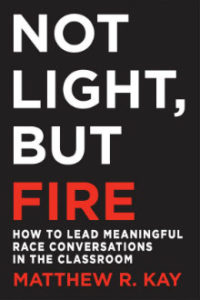Not Light, But Fire: Talking Race in Class
Not Light, But Fire: How to Lead Meaningful Race Conversations in the Classroom
By Matthew R. Kay
(Stenhouse, 2018 – Learn more)

While I was reading it, Matthew R. Kay’s Not Light, But Fire inspired me to change in real time the way I framed conversations about current events and history – which very often involve race, ethnicity, religion, politics and other incendiary topics.
For instance, in Kay’s English classes, students are “encouraged to cite each other in essays as reliable sources, as fellow experts, when such citations are appropriate” (20). I’ve always liked it when students refer to each others’ comments in discussion. But to actually “cite” their peers on essays? Brilliant, and one of my eighth graders who did this on a recent Constitution essay was so proud to include her classmate’s analysis.

As Kay states in the introduction: “This is an action book with a movement mission. It will live in the how of powerful race conversations, acknowledging that the above why has already been addressed” (50).
Taking this book seriously – which it demands with its topical and pedagogical weight – requires acknowledging just how many less-than-ideal practices even the most well-intentioned English and social studies teachers (i.e., me and maybe you too) use to elicit intense discussions from their students.
Two Sides of the Same Coin: February Soup and Systemic Oppression
In narrating classroom dialogues about particular texts and calling out educational assumptions about what we should teach, Kay gives food for thought.
Teachers will shake their heads with recognition when reading about what he calls February Soup, a nod to the “bland, scattered morass” that can be Black History Month: “After twelve years of February Soup conversations, students are apt to think that Martin Luther King freed the slaves with the ‘I Have a Dream’ speech. He was assisted by both Harriet Tubman and Rosa Parks, who ended all segregation when she refused to give up her seat on the bus” (96).
And teachers may rush to their curriculum guides when they encounter the obvious-in-retrospect point that we all too often teach about historically marginalized groups through the worst events that have happened to them.
As Kay reflects, “I’ve heard many students complain that when a class discusses race, the lens is always overcoming discrimination, violence or other systemic oppression. My senior African American Lit students once asked why their previous schooling hadn’t allowed them to discuss the intricacies of jazz and hip-hop, black cuisine, and the Black Arts Movement” (77).
This point hit home and made me want to beef up my 8th grade U.S. history reformers research project with even more standouts from underrepresented communities throughout history.
The Charisma Myth
At the beginning and end of the book, Kay pokes the Dead Poets Society model of the inimitable teacher who seems to be “born with immeasurable, unteachable stuff” (11). Instead, Kay – who seems to possess such charisma in buckets – argues that focusing on innate charm lets all teachers, even the sparkling ones, off the hook.
Instead, teachers need to cultivate humility, so that we can assess which moves launched a discussion forward and which shut our students down, sometimes unnoticed by us (but not by them). Ideally, teachers will “never blame conversational failures on our lack of charisma, our race, or our age. Instead, we will examine our techniques, isolate and develop our relevant communication skills, add to our conversational packages” (270).
This book left me longing for visitors to my classroom who will note which students grab their cell phones or laptops the moment I turn away (as Kay refreshingly describes happened to him). I want to invite colleagues to critique what I hope is a “dialogic classroom,” to use Kay’s term – to mark the moment my ego, self-importance or righteousness tramples over a student’s trenchant question.
Observers can help us “find ways to see the granular details we wouldn’t ordinarily notice. The chance to track our classrooms even twice a year might spark seismic change” (267) – change I want to be open for.
Don’t Be a Sensationalist or Carnival Barker
Kay wouldn’t suggest that we shy away from amping up discussion to create shining moments, and many of his classroom narratives travel through dramatic arcs.
But – in perhaps the greatest takeaway of the book for me – we need to be sure that such fiery interplay fits into the scope of the course. Such conversations can’t be throwaways, and they can’t be one-offs. Otherwise students might see us as no more than barkers at a carnival, stirring up intrigue only to shut it down when the wagons move on, or the bell rings.
One element I love about teaching social studies is that history and current events can lend themselves to such fireworks during each class. I can usually rely on a shocking statistic, headline or primary source to jump-start discussion.
But Kay cautions us against shock for the sake of shock, tears for the sake of tears. In reflecting on a Privilege Walk that he conducted in his early years of teaching, he admits: “The appeal is obvious. Theoretically, the students are shocked into a place of empathy; there are tears and declarations of newfound openness. From a teacher’s perspective, this is another good day” (89).
And yet, Kay continues, such drama can carry a dark underside: “When I did a similar activity with my students during a freshman drama class, one of my colleagues visited the classroom. Kids were crying. I felt proud of myself. Afterward, my colleague earnestly asked, ‘Is that what you wanted?’” (89)
Kay goes on to say that we as teachers have all the power – that the students had to engage with the activity he set up, that he was not ready to take responsibility if “this haphazard situation” made “some trauma bubble up” (90).
Instead of random and possibly destructive activities, Kay insists that we nurture “an always developing understanding” of questions about race, “not a single shock and awe moment” (91). Accordingly, we must embed and “thread” such discussions into meaningful essential questions that we tackle all year.
You Can’t Go Back
Having read this book, in many ways I feel I can’t return to the teacher I was. Anytime I bring up a controversial current event or historical issue, I’m now asking myself what my motives are and how it fits into our year’s essential questions in U.S. history.
And there’s so much more to Not Light, But Fire that I haven’t touched on – tending a protected space for discussion, giving “high-grade compliments,” addressing problematic language (including the “N-word”), asking students about the culture behind their names. This is not a book to be skimmed in one sitting, but instead to be digested, then acted upon.
And the need for acting is apparent, according to Kay: “This book acknowledges that if we are training the next generation of teachers, entertainers, lawyers, and politicians; if we are molding thoughtful citizens, wise counselors, and people of righteous passion; then our classrooms must be deliberate in their approach to conversations about race” (5).
I’m grateful for Kay’s very deliberate approach to writing a book that helps us do just that.
Sarah Cooper teaches eighth-grade U.S. history and is dean of studies at Flintridge Preparatory School in La Canada, California, where she has also taught English Language Arts. She is the author of Making History Mine (Stenhouse, 2009) and Creating Citizens: Teaching Civics and Current Events in the History Classroom (Routledge/MiddleWeb, 2017). She presents at conferences and writes for a variety of educational sites. You can find all of Sarah’s writing at sarahjcooper.com.



































